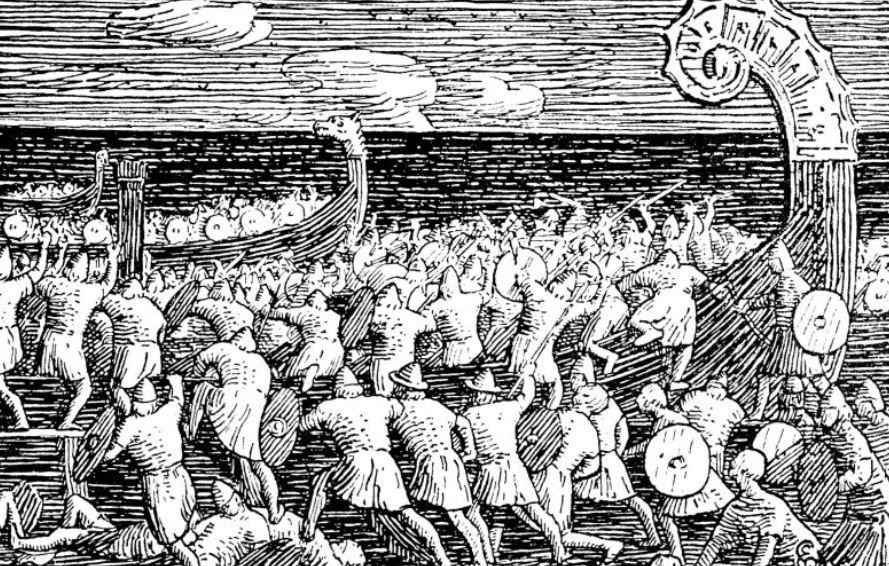The late 10th century was a time of existential crisis for Anglo-Saxon England.
Viking fleets, larger and more organized than ever before, prowled the coastline like wolves circling wounded prey. Each summer brought fresh horrors – monasteries in flames, towns reduced to smoking ruins, and terrified survivors fleeing inland with whatever possessions they could carry.
At the center of this storm stood Æthelred II, a monarch whose unfortunate nickname “Unraed” (meaning “ill-advised”) would forever color his historical legacy.
Faced with this unrelenting onslaught, Æthelred made a fateful decision that would define his reign: rather than continuing to throw his dwindling resources into increasingly futile military campaigns, he would pay the Vikings to leave.
This practice, would become known as Danegeld (“Dane-payment”), seemed at first glance a pragmatic solution. But as the payments grew larger and more frequent, they created a dangerous cycle of extortion that would ultimately weaken England more than any Viking army could.
This article examines Æthelred’s most famous – and controversial – Danegeld payment: his £16,000 deal with the fearsome Viking leader Olaf Tryggvason. We’ll explore how this transaction temporarily removed one threat while creating others, how it led to Olaf’s dramatic Christian conversion, and why this short-term solution may have contributed to England’s eventual conquest by the Danes.
1. The Rise of Olaf Tryggvason: Viking Menace to Christian King

A Warrior Forged in Blood and Fire
Olaf Tryggvason’s early life reads like something from Norse saga.
According to later Icelandic sources, he was born into Norwegian royalty but forced into exile as a child after his father’s murder. Captured by Baltic pirates and sold into slavery as a boy, he eventually regained his freedom through a combination of cunning and brute strength.
By his twenties, he had emerged as one of the most feared Viking commanders of his generation, leading raids from Ireland to the Baltic.
In the 980s and 990s, Olaf turned his attention to England.
His campaigns followed a now-familiar Viking pattern: swift coastal raids followed by demands for payment in exchange for temporary peace.
But Olaf was different from other Viking leaders in two crucial respects. First, his forces were exceptionally large and well-organized – more like a professional army than the typical Viking warband. Second, he seemed to possess an almost supernatural charisma that inspired fanatical loyalty among his followers.
The £16,000 Gamble
In 994, Olaf joined forces with another Viking king, Sweyn Forkbeard of Denmark, to launch what would become one of the most devastating attacks on England in decades.
Their combined fleet, reportedly numbering nearly 100 ships, ravaged the southeast coast before establishing a fortified camp near Southampton.
Æthelred’s response was unprecedented.
Rather than attempting to dislodge the Vikings through force (a strategy that had failed repeatedly in recent years), he offered them an astonishing £16,000 in silver to leave peacefully. To put this sum in perspective, it represented approximately 10% of England’s entire annual economic output at the time – enough to pay 160,000 skilled laborers for a month.
But Æthelred didn’t stop at mere payment.
He proposed something far more ambitious: Olaf would not only take the silver, but also submit to Christian baptism with Æthelred himself serving as godfather. This ceremonial adoption created a spiritual kinship bond that, in medieval thinking, made the two men family.
A Baptism That Changed History
The baptism took place at Andover, with all the pomp and ceremony the Anglo-Saxon court could muster.
Bishop Ælfheah of Winchester (who would later become Archbishop of Canterbury and die a martyr’s death at Viking hands) performed the rite, while Æthelred stood as sponsor.
For Æthelred, this was more than just a peace treaty – it was a masterstroke of political theater. By bringing Olaf into the Christian fold, he accomplished several objectives simultaneously:
- Removed a dangerous military threat without risking another costly battle
- Gained prestige as the ruler who converted a pagan warlord
- Created a potential ally in Scandinavia’s shifting power struggles
- Strengthened his image as a Christian king defending Christendom
Contemporary chronicles suggest the ceremony made a profound impression on Olaf. According to the Anglo-Saxon Chronicle, he “promised – as also he performed – that he would never come back to England in hostility.”
2. The Paradox of Danegeld: Short-Term Relief, Long-Term Peril

The Economics of Extortion
On the surface, Æthelred’s deal with Olaf appeared successful.
The Viking fleet departed, and England enjoyed a brief respite from attacks. But this temporary peace came at a steep price – both literally and figuratively.
The £16,000 payment represented just the beginning of England’s financial bleeding.
To raise these enormous sums, Æthelred’s government implemented a sophisticated (and burdensome) nationwide tax system. The Anglo-Saxon state, already one of Europe’s most advanced bureaucracies, became ruthlessly efficient at extracting wealth from its population.
Coin hoards from this period tell a grim story. Archaeologists have found numerous caches of silver pennies buried during Æthelred’s reign – likely by terrified citizens hiding their wealth from both Viking raiders and royal tax collectors.
The coins themselves show signs of debasement over time, as the government stretched its limited silver supplies to meet ever-growing demands.
The Psychological Toll
Beyond its economic impact, the Danegeld system had corrosive effects on English morale and political stability.
Each payment, while buying temporary relief, sent an unmistakable message: England was rich, vulnerable, and willing to pay for peace rather than fight for it.
This perception made the kingdom an increasingly attractive target.
As word spread through Viking trading networks, new warlords arrived to test Æthelred’s willingness to pay. The Anglo-Saxon Chronicle records at least eight major Danegeld payments between 991 and 1014, with the amounts growing larger each time:
- 991: £10,000
- 994: £16,000
- 1002: £24,000
- 1007: £36,000
- 1012: £48,000
The Unintended Consequences
Perhaps most damaging of all, the Danegeld system undermined Æthelred’s own military capabilities in several ways:
- Drained resources that could have been used to rebuild defenses
- Demoralized the nobility, who saw their wealth confiscated to pay invaders
- Created perverse incentives for local leaders to make separate peace deals
- Funded Viking ambitions elsewhere, as seen with Olaf’s conquest of Norway
By the early 11th century, England had effectively become a Viking cash machine – its wealth financing the very forces that threatened its existence.
3. Olaf’s Legacy: From Mercenary to Missionary
The Making of a Christian King
True to his word, Olaf never returned to attack England. But the silver he took from Æthelred became the seed money for an even grander ambition: the conquest and Christianization of Norway.
With his English wealth, Olaf assembled a formidable fleet and army.
In 995, he returned to his ancestral homeland and quickly overthrew the pagan ruler Håkon Jarl. Declaring himself king, Olaf launched one of the most aggressive Christianization campaigns in European history.
His methods were anything but gentle.
According to the Icelandic historian Snorri Sturluson, Olaf gave local chieftains a stark choice: accept baptism or face torture and death. In one particularly gruesome episode, he allegedly had a resistant pagan leader’s tongue cut out.
The English Connection
Olaf’s Christian revolution in Norway maintained strong ties to England. He brought with him English priests and bishops to help establish the new church.
The first bishop of Norway, a man named Thangbrand, was actually a Saxon missionary who had previously worked in England.
Architectural evidence suggests Olaf may have used English craftsmen to build Norway’s first Christian churches. The stone church he erected at Nidaros (modern Trondheim) bore striking similarities to Anglo-Saxon ecclesiastical architecture.
A Short but Influential Reign
Olaf’s rule proved brief but transformative. After just five years as king, he died in a sea battle against a coalition of Danish and Swedish forces in 1000.
Yet in that short time, he had:
- Established Christianity as Norway’s dominant religion
- Founded the city of Trondheim
- Created Norway’s first national coinage (modeled on English pennies)
- Laid the groundwork for a unified Norwegian state
Ironically, the wealth that enabled these achievements had come at England’s expense.
4. The Fatal Flaw: Æthelred’s Downfall
The Cycle Accelerates
As Olaf was carving out his Norwegian kingdom, conditions in England deteriorated rapidly.
Each Danegeld payment brought shorter periods of peace, while encouraging ever-larger Viking bands to try their luck.
The situation reached a breaking point in 1002 when Æthelred, frustrated by continued Viking encroachments despite his payments, ordered the infamous St. Brice’s Day Massacre – a coordinated attack on Danes living in England.
This act of desperation only provoked Sweyn Forkbeard (father of the future King Cnut) to launch a full-scale invasion.
The Final Reckoning
Between 1013 and 1016, Sweyn and later his son Cnut would complete what Olaf had begun decades earlier – the systematic extortion and eventual conquest of England. The very wealth that Æthelred had poured into Viking hands now financed the armies that would overthrow him.
In a bitter twist of fate, Æthelred died in 1016 as a fugitive in London, while Cnut was proclaimed king by the same English nobility who had grown weary of their ineffective ruler.
Conclusion: The High Price of Survival
Æthelred’s deal with Olaf Tryggvason encapsulates the tragic dilemma of his reign. Faced with an unprecedented Viking threat, he chose what appeared to be the pragmatic path – buying time and temporary peace through massive payments. Yet each payment weakened England’s long-term position while strengthening its enemies.
The £16,000 Danegeld of 994 achieved its immediate goal: it removed Olaf from the English chessboard. But in doing so, it:
- Established a dangerous precedent that other Vikings would exploit
- Funded the creation of a powerful Norwegian kingdom
- Depleted England’s resources when they were needed most
Historians continue to debate whether Æthelred had better options. Some argue he should have invested more in naval defenses or coordinated with European allies. Others maintain that given the overwhelming Viking advantage at sea, Danegeld was the least bad alternative.
What remains undeniable is that Æthelred’s policies – including his fateful bargain with Olaf – set in motion events that would lead to England’s conquest by the Danes and, ultimately, its transformation under Norman rule. The silver pennies paid to Viking warlords would, in time, help finance the very forces that reshaped medieval Europe.
In our modern era of geopolitical tensions and difficult compromises, Æthelred’s dilemma feels uncomfortably familiar.
When does appeasement become self-defeating? How do we balance short-term survival against long-term consequences? The story of England’s Viking payments offers no easy answers – only a cautionary tale about the high cost of buying peace from those who value silver more than honor.
Further Reading
If you enjoyed this article, you may enjoy these:
- The Anglo-Saxon State: How England Built Europe’s Most Centralized Medieval Government
- What happened to Edgar the Aetheling?
- Kings and Queens of England Ranked from Worst to Best
- How did Charlemagne improve the lives of people in Europe?
- Why was the crowning of Charlemagne so important?
You may also enjoy these articles about Medieval Europe:







